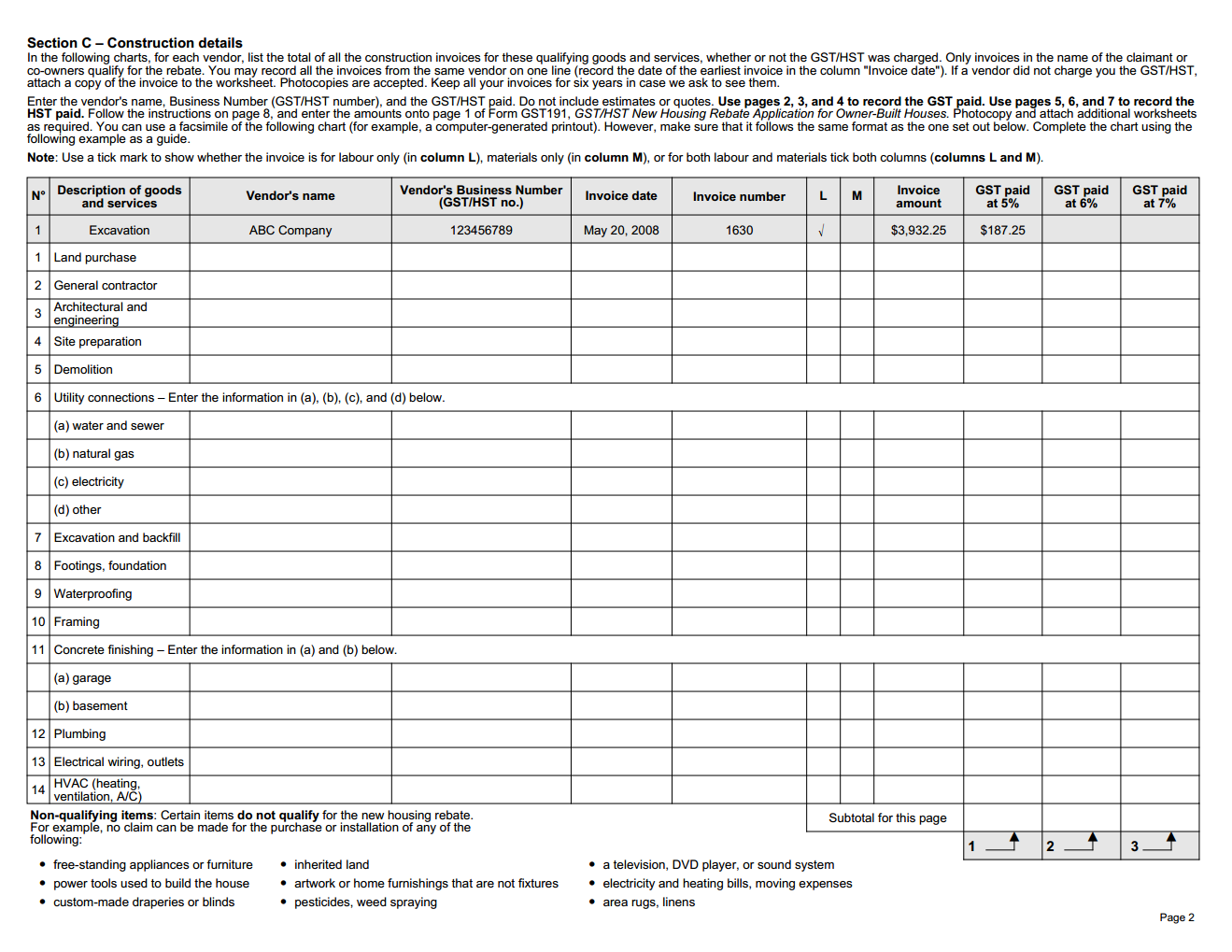Here’s an example of a lengthy job aid: Canada Revenue’s form GST191-WS, the Construction Summary Worksheet.
Who uses this job aid?
Canada Revenue has a process through which which certain homeowners can claim tax rebates for new construction, substantial renovation, and similar activity. Claims for owner-built homes (as opposed to homes purchased from a builder) use form GST 191. In order to submit the claim, the homeowner needs to complete this worksheet.
What’s this job aid for?
To receive a tax rebate, the applicant needs to document facts about the project, including the location of the construction, the construction period, and the fair market value of the property at the end of the project. In addition, the worksheet has six pages for documenting the various vendors, invoices, amounts paid, and amounts of GST (goods and services tax) paid.
Here’s page 2 as a sample. (Or, view the entire worksheet from the Revenue Canada site.)

Most projects, of course, will not have all of the 90-odd items listed (like flooring, built-in appliances, septic system, and land purchase). As a job aid, the worksheet is supporting two kinds of tasks: it prompts the applicant to consider an extensive list of possible expenses, and it guides the application through the processes needed to complete the actual application.
That’s why the final section of the GST191-WS worksheet includes a number of calculations based on data in the preceding seven pages: there are six important totals that the applicant will transfer to GST 191, the rebate application.

Comments
I haven’t read the instructions (which a sensible applicant would do), but I found some of the guidance in Section D confusing. I think it’s because the section uses digits to refer both to particular boxes (fields) for information, and for page numbers, and for labels within the section.
As an example, see the circled information:
After I enter the amount from box 4 on page 7, what do I do? Multiply it by the amount in box 5? Or multiply it by 5?
And then do I add the amount in box 12, or simply add 12?
I think in both cases the answer is “the amount in the box,” but the worksheet could say so explicitly:
Total amount in box 4 on page 7: ____
Multiply that answer by the amount in box 5: ____
Divide that answer by the amount in box 12: ____
That number 1, on the right, is apparently a label for this calculation–or for the result of this calculation. You can see in the sample of Section D that there are similar labels for the next two calculations, followed by the instruction to add the three together.
This part of the worksheet has nearly half a page of blank space. It’d be a good idea to test two versions of this summary on typical performers to see if clearly labeling helps to reduce errors.

Hi Dave, question for filling out the form, ie. 12 plumbing…we have multiple vendors and many invoices for each sections, question is how do we fill this out? Can we create our own worksheet labelled and formatted to the form but room to include many inserts of vendors, invoices, etc thank you so much for your time.
Jill:
Please excuse my delayed reply. I posted the worksheet as an example of a job aid, but in no way am I qualified to explain how to use it. I’m afraid you’d have to turn to the CRA or to an accountant.
— Dave
I had the same question as Jill. I printed off my own sheets so that I would have room for the different vendors under the same job description. I hope it’s allowed.
Jennifer, it’s not my form, so I can’t give or withhold permission.
Keep in mind this example is now eleven years old.
I searched for “GST191 CRA” and found a like at the CRA site today (Nov. 5, 2023). That might be a good place to start:
GST191-WS Construction Summary Worksheet
I would like to know what you ended up doing because I’m on that same bought you sailed in and man I feel like jumping overboard looking at this sheet.
Clearly the form and the process it’s part of are in need of some improvements.
I’m afraid this is something people will have to take up with their accountants. The Ensampler is a vehicle for discussing how, when, and why to create job aids. I can’t give advice on how to apply CRA forms, let alone rules.
I’m going to close comments on this post.